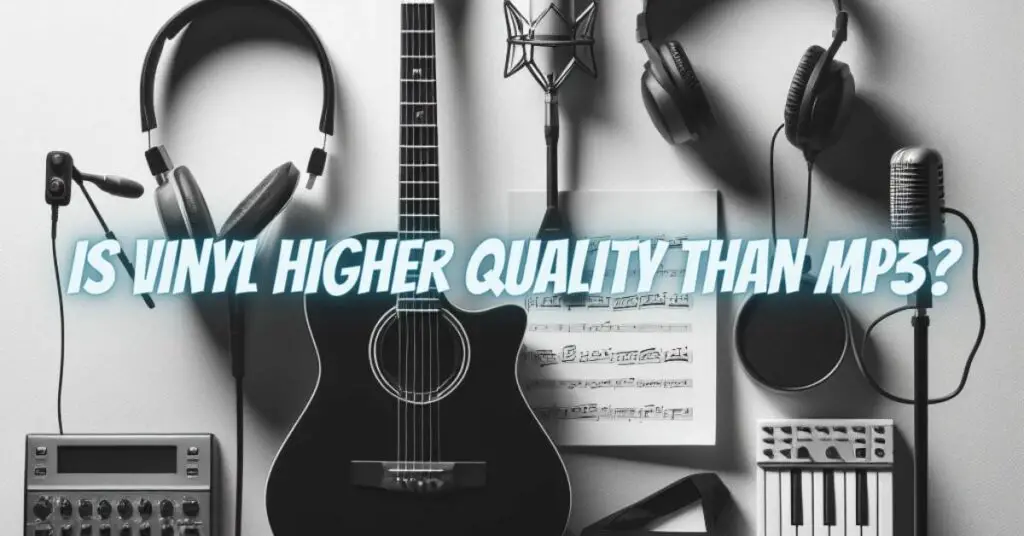The comparison between vinyl records and MP3 files revolves around their distinct characteristics, sound quality, and overall listening experience. Each format appeals to different listeners and audiophiles based on preferences for fidelity, convenience, and the tactile nature of music consumption. Let’s delve into the differences and considerations regarding the quality of vinyl compared to MP3:
Understanding Vinyl Records
- Analog Format:
- Vinyl records store audio in an analog format, where audio signals are physically represented by grooves engraved into the vinyl surface.
- Sound Characteristics: Vinyl records are celebrated for their warm, rich sound quality characterized by natural analog sound reproduction. The continuous groove modulation captures subtle nuances and details that digital formats like MP3 may not fully replicate.
- Tactile Experience:
- Vinyl offers a tactile and immersive experience, from handling the physical record to the ritual of playing it on a turntable. Many enthusiasts appreciate the artwork, liner notes, and collector’s value associated with vinyl albums.
Understanding MP3 Files
- Digital Format:
- MP3 is a compressed digital audio format that reduces file size by discarding parts of the audio signal deemed less critical to human hearing.
- Compression: MP3 files typically use perceptual coding techniques to achieve compression rates while aiming to retain sufficient audio quality for most listeners.
- Sound Characteristics:
- MP3 files offer convenient storage and playback options with small file sizes, making them ideal for digital music libraries and portable devices.
- Lossy Compression: The compression process may result in a loss of some audio information, particularly at lower bitrates, which can affect perceived sound quality, especially for critical listeners.
Sound Quality Comparison
- Fidelity and Detail:
- Vinyl records are often perceived to offer higher fidelity and detail compared to MP3 files, particularly at higher bitrates and in optimal listening environments.
- Analog vs. Digital Sound: Analog playback from vinyl can provide a more natural, dynamic range with a warmer sound profile, whereas MP3s may exhibit artifacts or a slight loss of fidelity due to compression.
- Listening Experience:
- Vinyl enthusiasts value the organic, immersive sound of analog playback and the physical interaction with records, which enhances the overall listening experience.
- Convenience vs. Fidelity: MP3 files prioritize convenience and portability, offering instant access to vast music collections but may sacrifice some nuances and depth found in vinyl records.
Listener Preferences and Subjectivity
- Personal Preference:
- The preference for vinyl or MP3 often depends on individual taste, listening habits, and the desired listening experience. Some listeners prioritize convenience and digital accessibility, while others value the unique sound characteristics and tactile nature of vinyl.
- Context of Use:
- MP3s are favored for their ease of use, portability, and compatibility with digital devices and streaming platforms. They provide instant access to music in various environments, from commuting to exercising.
- Vinyl records appeal to enthusiasts seeking a deeper connection to their music collection, appreciating the ritual of vinyl playback and the sonic qualities that analog formats offer.
Conclusion
The question of whether vinyl is higher quality than MP3 depends on one’s priorities and preferences in music consumption. Vinyl records excel in providing a warm, rich sound with analog authenticity and a tactile, immersive experience. MP3 files prioritize convenience, portability, and digital accessibility but may exhibit limitations in audio fidelity and depth compared to vinyl.
Ultimately, both formats contribute uniquely to the diverse landscape of music enjoyment, catering to different audiences seeking either the convenience and digital accessibility of MP3 or the tangible, artistic experience and analog warmth of vinyl records. The choice between vinyl and MP3 remains a matter of personal preference, listening habits, and the desired aesthetic and emotional connection to music for each individual listener.

